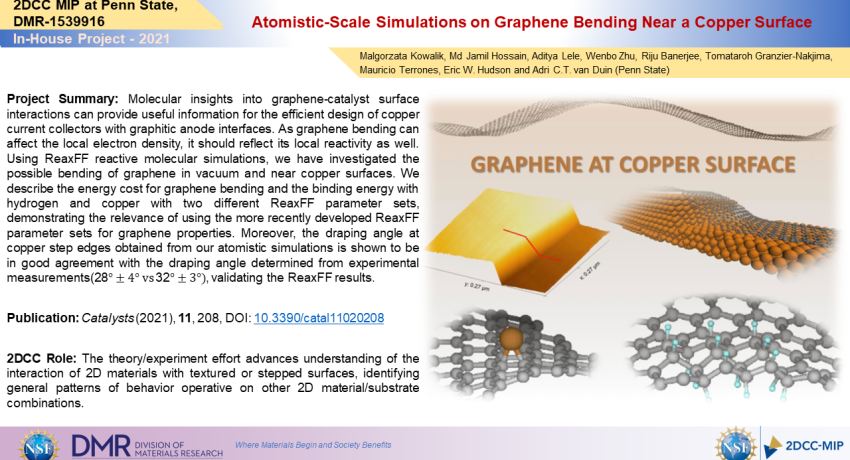Project Summary: Molecular insights into graphene-catalyst surface interactions can provide useful information for the efficient design of copper current collectors with graphitic anode interfaces. As graphene bending can affect the local electron density, it should reflect its local reactivity as well. Using ReaxFF reactive molecular simulations, we have investigated the possible bending of graphene in vacuum and near copper surfaces. We describe the energy cost for graphene bending and the binding energy with hydrogen and copper with two different ReaxFF parameter sets, demonstrating the relevance of using the more recently developed ReaxFF parameter sets for graphene properties. Moreover, the draping angle at copper step edges obtained from our atomistic simulations is shown to be in good agreement with the draping angle determined from experimental measurements(28°±4° vs°±4° vs 32°±3°)°±3°), validating the ReaxFF results.
Publication: Catalysts (2021), 11, 208, DOI: 10.3390/catal11020208
2DCC Role: The theory/experiment effort advances understanding of the interaction of 2D materials with textured or stepped surfaces, identifying general patterns of behavior operative on other 2D material/substrate combinations.
What Has Been Achieved: We demonstrated the relevance of using a recently developed ReaxFF parameter sets for graphene properties as well as determined the the binding energy for flat and bent graphene with hydrogen and copper atoms. Moreover, the draping angle at copper step edges obtained from our atomistic simulations was shown to be comparable to the experimentally measured draping angle, validating the ReaxFF results.
Importance of the Achievement: This force field validation showing the ReaxFF capability to capture a higher reactivity of the bended region of the graphene as well as to predict the value for the draping angle comparable with the experimental value.
Unique Feature(s) of the MIP that Enabled this Achievement: The resources provided by the Institute for Computational and Data Sciences Advanced Cyber Infrastructure (ICDS-ACI), was used to perform the ReaxFF simulations. The 2DCC facility provide a unique platform for our simulations and experimental groups to collaborate.
Publication: Kowalik, Malgorzata, Md Jamil Hossain, Aditya Lele, Wenbo Zhu, Riju Banerjee, Tomotaroh Granzier-Nakajima, Mauricio Terrones, Eric W. Hudson, and Adri CT van Duin. "Atomistic-Scale Simulations on Graphene Bending Near a Copper Surface." Catalysts 11, no. 2 (2021): 208.
This work was supported by DoE-NETL DE FE0026825 UCFER, the U.S. Army Research Laboratory through the Collaborative Research Al-liance(CRA) for Multi-Scale Multidisciplinary Modeling of Electronic Materials (MSME) under Cooperative Agreement No. W911NF-12-2-0023, NASA Space TechnologyResearch Institute (STRI) for Ultra-Strong Composites by Computational Design (US-COMP), grant NNX17AJ32G and NSF DMR grants #1539916 and #1808900 as well as the Penn State Two-Dimensional Crystal Consortium-Materials Innovation Platform (2DCC-MIP) funded by the U.S. National Science Foundation (DMR-1539916).
